Polyvinyl Alcohol Slime
In this experiment, a polymer (polyvinyl alcohol) chemically reacts with borax to form a crosslinked polymer network. Individual polymer chains are formed by covalent bonds, which are strong bonds. In making slime, the individual polymer chains are bound together by weak hydrogen bonds. The resulting polymer network is composed of strands of polyvinyl alcohol held together side-by-side by the borate molecules. It is evident that this crosslinking is weak because of the ease with which the slime flows and pulls apart. However, even though this crosslinking is weak, it does alter the properties of the resulting polymer.
Toy stores carry the materials needed for this experiment in kits (look for "slime" or "goop"), or the final product can be purchased as Gak™. The slime mixture is non-toxic, but the borax and PVOH can be irritating to the eyes, so use safety glasses and wash hands at the end of the experiment. The slime may stain clothing and carpeting, so care should be exercised. The slime should be discarded in the trash and NOT down the drain, as it may clog the drainpipe. It tends to dry out if left exposed to the air, so store it in a sealed plastic bag.
Supplies needed:
- Polyvinyl alcohol solution (instructions for preparation included below)
- Borax solution (instructions for preparation included below)
- Small (3 oz) cup
- Plastic teaspoon
- Wooden stick
- Waxed paper
Procedure:
1. Measure 2 tsp. of polyvinyl alcohol polymer solution into a cup.
2. Add 1/4 teaspoon of Borax solution. Mix well with a wooden stick.
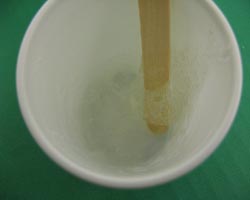
3. Touch and try to pour the product. How does it feel? Can it be poured?
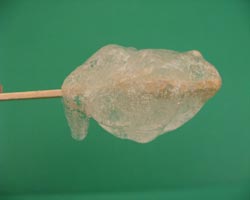
4. Working on waxed paper, roll the "slime" into a ball and try to bounce it. Does it bounce? If desired, add talcum powder to the slime ball to decrease its stickiness.
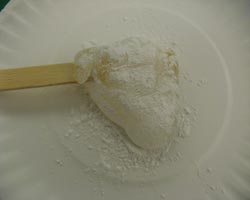
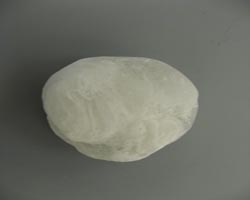
5. Let it sit for a while. What happens to it?
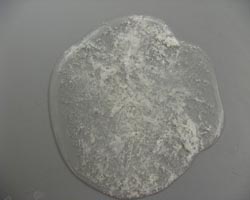
6. Try to pull it apart quickly. Next try to pull it apart very slowly. Try to cut the slime with a spoon. How does it behave? Is it a liquid or a solid? Support your answer with observations.
The slime product behaves sometimes as a liquid and in other cases as a solid. Such behavior is called "viscoelasticity" and materials are said to be "viscoelastic". Liquids can be poured and solids maintain their shape. How does this material compare as a solid and/or a liquid?
There are a number of variations that can be made to this experiment. By adding 1 teaspoon of talcum powder or cornstarch to the polyvinyl alcohol in the first step, the polymer properties can be changed. The talcum powder or cornstarch act as "filler" and result in a very different product and behavior. In industry, fillers such as talc and carbon black are added to crosslinked polymers to adjust and vary properties such as color and strength. Filler also reduces the cost of the product since the filler materials are generally inexpensive.
The addition of glitter or confetti to the polymer solution makes a very attractive slime!
Put your slime in the refrigerator or freezer to cool it below room temperature. Be sure it is in a plastic bag or wrapped in plastic wrap so it won't dry out. How do the properties of the polymer change with temperature? Do plastics behave differently outdoors in freezing weather compared to indoors at room temperature?
For a more elaborate experiment, have different groups of students use different amounts of sodium borate. For example, divide students into 5 groups. Have one group add 2 ml of borax to 100 ml of PVOH solution. The others groups should add 4, 8, 12, and 20 ml of borax to the 100 ml of polymer solution, respectively. This should more easily demonstrate the effects of crosslinking on the properties of the polymer. Using more sodium borate results in more crosslinking. Students can stretch or roll the slime into long ropes and determine which slime (which amount of crosslinking) is best for this.
For high school chemistry classes, refer to the article Casassa, E.Z., Sarquis, A.M., Van Dyke, C.H., J. Chem. Ed., 63, 57, 1986, for details about the chemistry of polyvinyl alcohol slime.
PREPARATION OF SOLUTIONS FOR THIS EXPERIMENT:
4% Polyvinyl Alcohol (PVOH) Solution
- Dissolve 40 grams of PVOH powder (molecular weight of ~100,000, Polysciences, Inc.) in 900 ml of distilled water.
- Heat gently for several hours until dissolved (solution turns clear). Make sure the solution does not boil, or the properties will be altered.
- Dilute to 1 liter with more water.
- The prepared solution should be clear and somewhat viscous. It stores well in the refrigerator until needed.
- A 4% PVOH solution is also available from Flinn Scientific.
4% Sodium Borate, Na2B4O7 * 10 H2O, Solution
- Dissolve 10 grams of sodium borate in 250 ml of distilled water. You can obtain Borax at the grocery store near the laundry detergent.